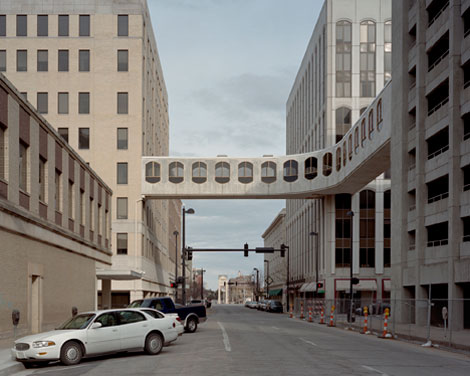Through a process of intellectual, historical and geographic research, Alex Slade makes evident, and critiques thereby, the social forces that shape the American landscape. Landscape-oriented American photographers have been preoccupied with this issue since the 1970s, but have manifested the message poetically and metaphorically, as in most work associated with the New Topographics. Slade, by contrast, takes on a didactic air in his latest exhibition “What City Pattern?”—without subordinating aesthetic considerations to social ones.
Slade seeks to eschew as much romantic response as he can in his photographs, and certainly by including documents and sculpture-like elements in his exhibitions he presents evidence of ideals betrayed, sidelined, or co-opted. Slade does so with a deadpan worthy of New Topographics photographers such as Lewis Baltz or Stephen Shore, but also with a critical eye that clearly takes up the deconstructive outlook of a neo-social photographer like the late Allan Sekula. As much as these predecessors, Slade transcends the self-effacing, reportorial offhandedness and pretense at objectivity that make a virtual cliché of photo-journalism. He relies instead on the opposite cliché, making sure to make art of his imagery. This sets the realities of his land- and cityscapes, brimming with social implication, into starker contrast.
Slade’s landscapes, whether Midwest farmland or California desert, are gloriously bleak vistas, vast expanses visually distinguished as much by manmade as by natural structures. In these, Slade shows his New Topographic roots, but consciously admits the fact that he’s at least a generation behind: whereas the topographies of a Robert Adams anticipate a taming and degradation of nature, Slade’s show that the process has been pretty much completed. The results are neutralized, bland, rural non-sites much more akin to early Robert Smithson than to latter-day Edmund Bortynsky. Slade’s urban/suburban views conjure Smithson even more emphatically, brimming as they are with city centers compromised by outsize postwar buildings, which now have slipped into disuse and decay. Not a few of these buildings are themselves architecturally notable, for better or worse; and when he gets close to them, at least, Slade cherishes their details and their design aspects, à la Julius Shulman. Even there, however, Slade reveals corrosive forces at work—at work against each other, that is, architectural pretense coming up against the ravages of climate and vandalism.
In defining what Slade does, any number of older photographers can be cited, not to rely on them simply as stylistic tropes, but to place Slade squarely in a North American tradition of landscape photography, one that (as frequently done by Smithson) encompasses conceptual and land-art investigation. By including in his exhibition objects that exemplify the techniques of mid-century design and periodicals that promulgated these techniques and the (post-Bauhaus) attitudes behind them, Slade further conflates issues and practices relevant to the social landscape of postwar America. He thus underscores the Ozymandian tone of his photographs, articulating the prime postmodern plaint against modernism: no matter how well designed, the road to hell is paved with good intentions.



















0 Comments